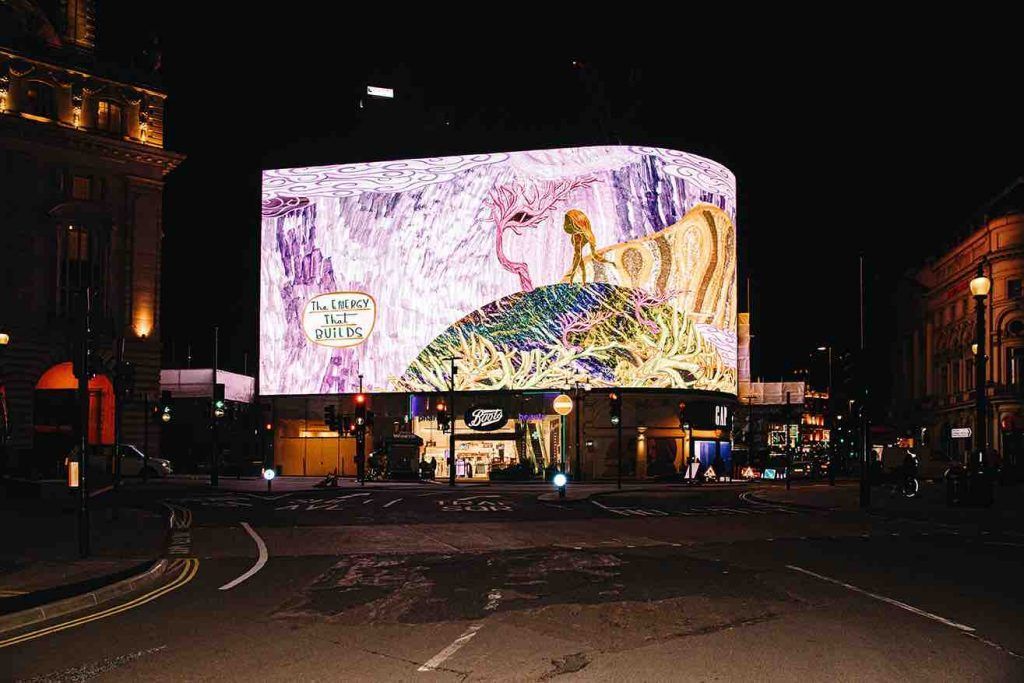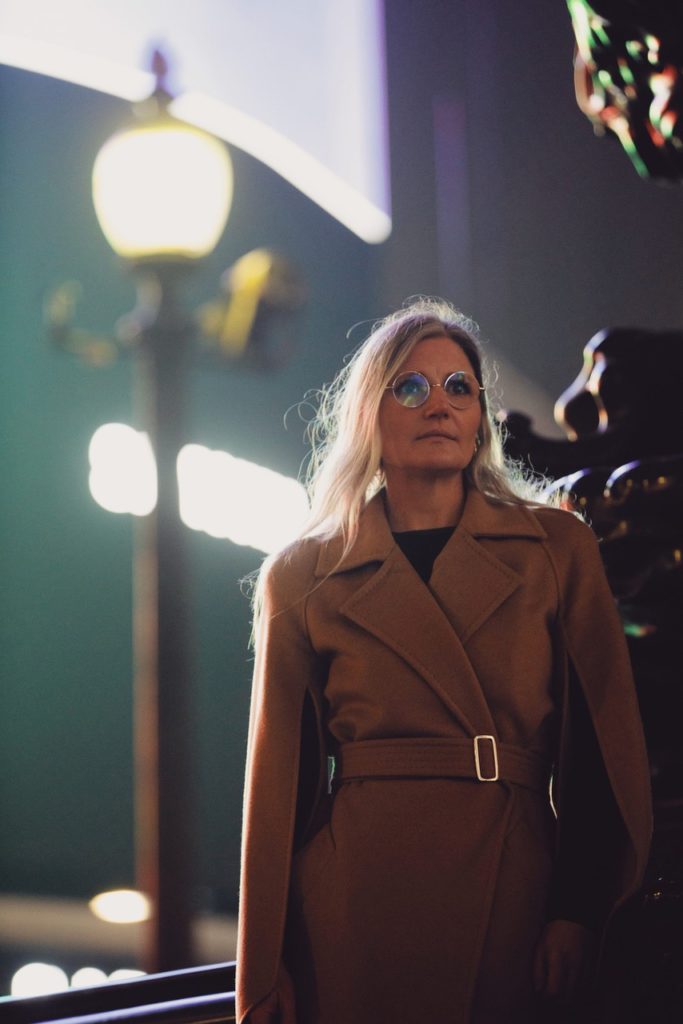Ouroboros Time in the Universe of Emma Talbot
Written by Louisa Elderton

What may your vision for a hopeful future look like? How to explicate the way the world could be? How to harness time; fold it, elongate it, compress it according to the shapes that you want to see? And how may your body move in relation to these shapes, with skin that wants to feel? As depicted by the British artist Emma Talbot’s work, fingertips curl into themselves if there is no one else to touch. Plant tendrils coil as they climb, spiralling, stretching for support. Galaxies assiduously swirl, systems of stars, dust and dark matter that are gravitationally bound and yet celestial. There are infinite such layers that constitute our universe, but what else could our world be? Or rather, how else could it function?
Talbot’s series of four animations for CIRCA, Four Visions For a Hopeful Future (all works 2021), conjures such questions. Of a post-viral world that needs re-birthing. Known for her drawings, paintings and sculptures that combine word and image to narrate the complex nature of human existence, these are Talbot’s first animations, a self-taught skill that she learnt in 2020 during the UK’s first coronavirus lockdown.

They describe the pressures and inequalities that we have been living under, not only as the result of the COVID-19 pandemic but prior to this even, under an accelerated capitalist structure. In the animation What is a City?,one of Talbot’s faceless figures – the artist’s signature bodies that reflect both her own interiority, as well as being a proxy for every body – is blown down a street, past row upon row of houses, turning and tumbling uncontrollably in a turbulent wind. They climb an enormous staircase, weighted by outsize arms, only to reach the top and topple into a void, falling as columns crash all around – a system collapsing into ruins. Talbot asks, are you part of a city, making decisions that have an effect, or are you a sleeping partner? Does the city see you? Is your image reflected in the windows of skyscrapers or are you rendered invisible?
The coronavirus pandemic has held up a mirror to the structural racism in the UK’s labour market. A recent study has revealed that jobless rates among BAME groups are now double the rate for white people. As the TUC general secretary, Frances O’Grady, has said: “When BME workers have held on to their jobs, we know that they are more likely to be working in low-paid, insecure jobs that put them at greater risk from the virus. This is evidence of the structural discrimination which has led to a disproportionate BME death rate from coronavirus”.1
Having read and reflected on the Belgian philosopher Isabelle Stengers’ 2009 book In Catastrophic Times, Resisting the Coming Barbarism, Talbot describes how, “I was thinking a lot about how we imagine a future […] this idea of a set of structures that we’ve lived under and that we could rethink. How they function, how they could be kinder in terms of what is expected from a human experience. But also in terms of productivity, how they operate and what a life equates to. How we could build communities, be more experimental.” 2 Four Visions For a Hopeful Future is about how we can imagine (and represent) moving from one phase into a very different way of living. It is about hope for another mode of existence in which all people have subjectivity. And where there is enough space, enough scope for this to be shared.

Drawing and cutting out motifs and figures before layering theses and moving each part in stop motion animation, the worlds that Talbot creates are drawings in which people walk around – move, explore. Her accompanying soundscapes layer operatic voices with vibrating synths and deep base notes that have sensorial resonance. Our Own Creation speaks to the beginning of a new time, where the clouds part and a faceless person is born from a hole in the sky. An ever-rotating planet is marked by mercurial swirls. Snakes rise up in salute, forming undulating patterns. Multi-coloured birds fly through a whirling atmosphere. Below, a tree grows and then sheds its leaves, respecting the seasonal cycle. This is an expanding universe where life moves gradually, where we are integrated, connected to the earth and nature. This is slow time, removed from the hyperactive speed of late-capitalist living.
Indeed, there is a timelessness about these worlds; spaces where past, present and future seem to whirl as one. Ouroboros time. Archetypal time. A collective unconscious brought into being. However, while these may look like dreamscapes, utopias, they are grounded in a developing movement of thought that is part of our contemporary zeitgeist. Arundhati Roy’s essay ‘The Pandemic is a Portal’, for example, describes the coronavirus as “bringing the engine of capitalism to a juddering halt.” 3 She asks, if capitalism is like a train crash, what does one do amid the wreckage? You can look at it and think about how to replace the parts, or alternatively, you think about how to build a new engine.
These ideas may sound utopic, but they are actually possible and there is a growing weight behind such ideas. As Talbot says, “It is possible for us to think differently about how our lives are structured, as well as production and food production – responsible ways to go about living. It’s about whether you believe that’s the right way to be moving forward, or whether you have a vested interest in clinging onto what was before. There are systemic inequalities at all levels of the structures that we live in. It’s not impossible to say it doesn’t have to be like that.” 4
The artist’s animations ask us to dive into the undertow, to look beyond the surface of the water that has mesmerised us with our own reflections, to breath out and move in a different direction, together.
1 Nazia Parveen, ‘Covid job losses show structural racism of UK labour market, says TUC’, The Guardian, 27th February 2021, https://www.theguardian.com/society/2021/feb/27/covid-job-losses-show-structural-racism-uk-labour-market-tuc(accessed 27th February 2021).
2 Interview with the author Louisa Elderton, 27th February 2021.
3 Arundhati Roy, ‘The Pandemic is a Portal’, The Financial Times, 3rd April 2020, https://www.ft.com/content/10d8f5e8-74eb-11ea-95fe-fcd274e920ca (accessed 28th February 2020).
4 Interview with the author. Op. cit.
Louisa Elderton is a writer, editor and art critic based in Berlin. She regularly contributes to publications including Artforum and Frieze, and is the German correspondent for Flash Art. She is the Curatorial Editor at the Gropius Bau, having written the texts for the institution’s upcoming exhibition Yayoi Kusama: A Retrospective, and editing their Online Journal. She is also the Editor of Side Magazine, a publication that accompanies the fourth edition of the Bergen Assembly, taking place in 2022. As the Project Editor of Phaidon’s ‘Vitamin’ series, her most recent publication was released in January, Vitamin D3: Today’s Best in Contemporary Drawings.